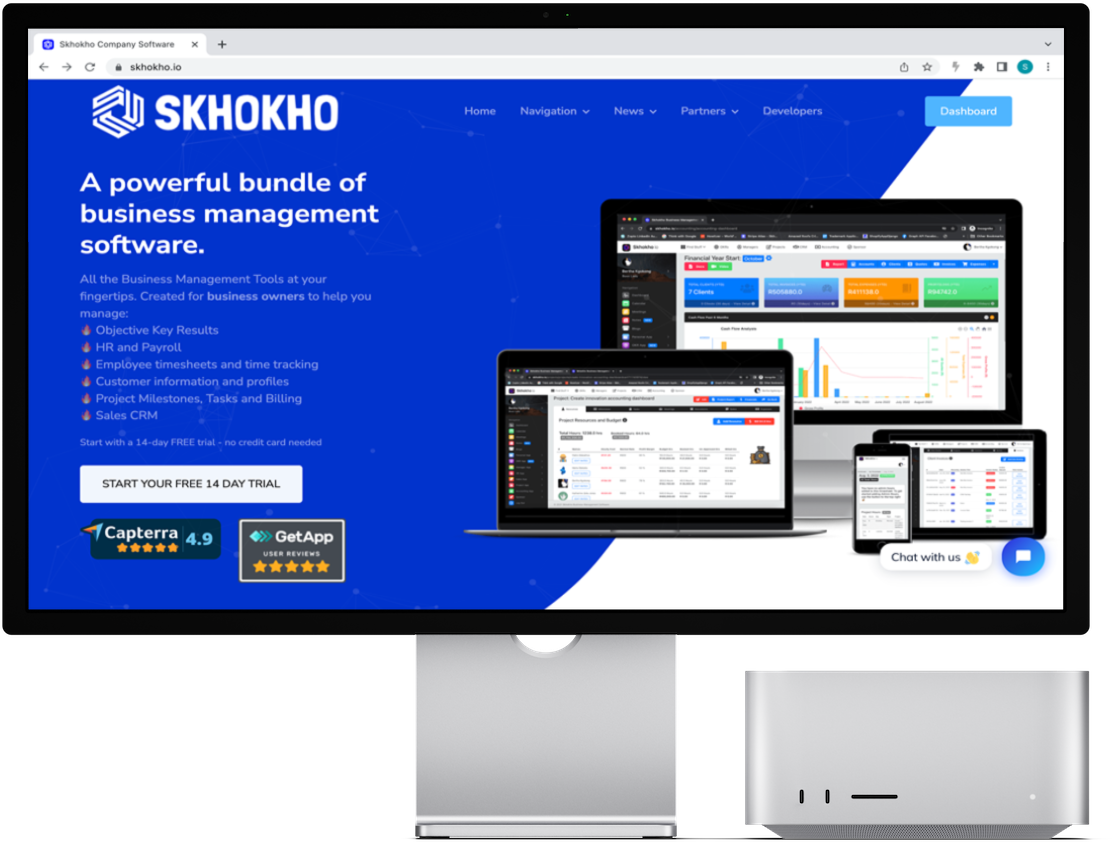Getting Your Business Ready: Setting Goals and Prioritizing Strategies for a Successful Year Ahead
The start of a new year is the perfect time for entrepreneurs to take a step back and evaluate their business. As the new year has begun, now is the time to reflect on the past year and consider the opportunities and challenges ahead. This can be the ideal moment to assess your business's strengths and weaknesses, set new objectives and establish a plan to achieve them.
Business planning for the new year should also consider both short-term and long-term goals, as well as considering both internal and external factors. Entrepreneurs must be proactive in anticipating and adapting to changes in the market, technology and the economy. A solid business plan will help entrepreneurs to respond quickly and effectively to shifting market conditions and new opportunities.

Preview the main points of the post
- The importance of setting goals and making a plan
- Setting Goals
- Prioritizing Strategies
- Evaluating Progress
- Best way to get your business ready
The Importance Of Setting Business Goals And Making A Plan
Setting goals and making a plan is an essential part of the business planning process because it helps entrepreneurs and small business owners to identify what they want to achieve and how they intend to achieve it. Goals provide direction and focus, and give entrepreneurs a sense of purpose and motivation. They also provide a clear target for all the organization's efforts and a framework for decision-making.
Having a plan provides a roadmap for achieving the goals. It outlines specific strategies and tactics that will be used to achieve the goals and provides a clear understanding of the steps needed to reach them. It also helps in breaking down the goals into smaller, manageable tasks and identifying the resources and support that will be needed to achieve them.
Moreover, making a plan allows entrepreneurs to anticipate potential obstacles and develop strategies to overcome them. It also helps to identify potential growth areas and allocate resources accordingly. By setting goals and making a plan, entrepreneurs can ensure that they are making the most of their time, effort, and resources.
Setting Goals

The benefits of setting clear and measurable goals for the new year
Setting clear and measurable goals for the new year has several benefits. These include:
- Motivation: Setting specific, achievable goals provides a sense of purpose and motivation to work towards something tangible and attainable. This can help entrepreneurs and their team members to stay focused and engaged, which can lead to increased productivity and job satisfaction.
- Clarity and direction: Clear goals provide a sense of direction and clarity, and give the organization a clear target to work towards. This can help to focus efforts, resources, and decision-making, which can ultimately lead to success.
- Prioritization: When goals are clear and specific, it makes it easy for entrepreneurs and their teams to prioritize tasks and allocate resources effectively. This can lead to more efficient use of time, money, and resources.
- Progress tracking: When goals are measurable, entrepreneurs can track their progress and measure the success of their efforts. This allows for regular reviews and adjustments as needed, which can help to keep the organization on track to achieve its objectives.
- Flexibility: Setting measurable goals allows for more flexibility in decision making, as it allows entrepreneurs to make adjustments as needed to meet their objectives.
- Accountability: Measurable goals make it easy to hold oneself and others accountable, as progress can be tracked and measured. This can lead to increased transparency and accountability within the organization, which can ultimately lead to better performance and results.
Goal Setting Process: Setting Effective Goals
Setting effective goals is a critical process for any business. One way to set effective goals is by following a process that includes goal identification, alignment and measurement.
Goal identification: The first step in setting effective goals is to identify the areas of your business where you want to see improvement or growth. This could include areas such as revenue, market share, customer acquisition, or employee engagement. Ask yourself what success looks like in each of these areas, and define the objectives that align with those areas.
Goal alignment: Once you have identified your goals, align them with your overall business strategy. Ensure that they are consistent with your company's mission and vision, and that they are in line with the overall direction of your business. This will ensure that your goals are truly aligned with the company's objectives.
Goal setting: Use the SMART criteria to make your goals specific, measurable, attainable, relevant, and time-bound. This helps to ensure that the goals are specific, achievable and with a clear deadline.
Goal measuring tools: Establish Objective Key Results (OKRs) that align with your goals, use them to measure progress, and establish regular monitoring and review schedule. This will allow you to track progress and make adjustments as needed to ensure that you are on track to achieve your goals.
Prioritizing Strategies: Strategic Plan

The importance of prioritizing tasks and allocating resources effectively
Setting strategic goals, prioritizing tasks and allocating resources effectively is important for several reasons.
- Efficiency: When entrepreneurs prioritize tasks and allocate resources effectively, they are able to focus on top priorities and urgent tasks first, which can help to ensure that the organization is using its time and resources in the most efficient way possible.
- Resource optimization: By prioritizing tasks, entrepreneurs can ensure that resources are allocated to the most important and high-impact tasks. This can lead to greater resource optimization and maximize the impact of their efforts.
- Better use of time: Prioritizing tasks can help entrepreneurs to use their time more effectively, and minimize wasted effort on less important or lower-priority tasks.
- Increased productivity: When entrepreneurs and their teams know what tasks are most important and what resources are needed to complete them, they can work more efficiently, which can lead to increased productivity.
- Flexibility: Prioritizing tasks allows entrepreneurs to be more responsive to changes in their environment, as they can quickly adjust their plans and resources as needed to meet new opportunities or challenges.
- Better allocation of budget: Prioritizing tasks also helps with allocating budget effectively, by focusing on the most important and impactful activities, entrepreneurs can make the most of the budget.
Process for Prioritizing Tasks: Strategic Planning Process
Prioritizing tasks can be done by using a combination of techniques such as SWOT analysis and using a prioritization matrix. SWOT analysis is a tool that helps to identify a company's strengths, weaknesses, opportunities, and threats.
This can be used to identify the most important tasks that need to be prioritized in order to achieve the goals set. Once you have identified the tasks, you can use a prioritization matrix to organize them according to their importance and urgency.
The matrix typically has two axis, one for importance and the other for urgency, and it helps to visually represent the tasks and prioritize them by assigning them to different quadrants such as High-priority, Medium-priority, Low-priority tasks. This will help to ensure that the most important and urgent tasks are completed first while less important tasks can be scheduled for later.
Tips for Creating A Realistic And Actionable Plan Of Action
Creating a realistic and actionable plan of action is essential for achieving business goals. Here are a few tips for creating a plan of action that is both realistic and actionable:
Break down larger goals into smaller, manageable tasks: This makes it easier to prioritize and focus on the most important tasks, and ensures that the plan of action is actionable.
Identify specific, measurable milestones: This helps to track progress and measure success, and also helps to identify when adjustments need to be made.
Assign specific roles and responsibilities: Clearly identifying who is responsible for specific tasks or milestones can help to ensure that the plan of action is executed effectively.
Establish deadlines: Deadlines can provide a sense of urgency and help to keep the plan of action on track. Make sure that the deadlines are realistic and actionable.
Allocate the necessary resources: Ensure that the plan of action has the necessary resources to be executed, including budget, personnel, equipment, and technology.
Monitor progress regularly: Regularly monitoring progress can help to identify any potential issues and make any necessary adjustments.
Be flexible and adaptable: Be prepared to adjust the plan as needed, in response to changes in the market, the economy, or other factors that may affect the business.
Communicate the plan of action to all stakeholders: Communicate the plan of action with all stakeholders and make sure that they understand their role in the plan and are aware of the progress.
By following these tips, entrepreneurs will be able to create a plan of action that is realistic and actionable, and that can be executed effectively. A well-crafted plan will help to ensure that the organization is working towards its goals and objectives in an efficient, and effective manner.
Evaluating Progress: Measure Progress

The Importance Of Monitoring Progress And Making Adjustments As Needed
Monitoring progress and making adjustments as needed is an important part of the business planning process because it helps entrepreneurs and small business owners to track their progress towards achieving their goals and make any necessary adjustments to keep the organization on track. It ensures that you stay on track to reach your objectives and that you're making the most of your time, effort, and resources.
Regular monitoring of progress allows entrepreneurs to evaluate their progress, measure the success of their efforts, and identify any areas where improvements can be made. By identifying any obstacles or roadblocks, entrepreneurs can develop strategies to overcome them, and adjust their course of action if needed.
Making adjustments as needed also helps entrepreneurs to stay agile and responsive to changes in the market, technology and the economy. This is crucial to the success of any business as it enables entrepreneurs to respond quickly and effectively to shifting market conditions and new opportunities, rather than being caught off guard.
Strategies For Evaluating Progress
One key strategy for evaluating progress is to use metrics and objectives key results (OKRs). Metrics are quantifiable measurements that help to track progress towards achieving a specific goal or objective (more like key performance indicators). They can be used to measure various aspects of your business, including financial performance, customer satisfaction, employee engagement, and marketing team effectiveness, among others. By setting clear and measurable goals, entrepreneurs can track progress against specific targets, and measure success.
Using metrics and OKRs are an effective way of evaluating progress, as they provide a clear and measurable way to track progress towards achieving specific goals. Entrepreneurs can use these metrics to evaluate their progress over time, and identify trends and patterns that can help them make better decisions for the business. Additionally, these are objective data points that can be used to measure performance, and make data-driven decisions. These can help entrepreneurs to evaluate the efficiency and effectiveness of their strategies and make adjustments as needed to keep their business on track.
Tips for Making Data-driven Decisions & Taking Corrective Actions
To make data-driven decisions and take corrective actions, entrepreneurs should:
- Identify the right data
- Regularly collect and analyze data
- Act on the data
- Create a feedback loop
- Continuously improve
By following these tips, entrepreneurs can make more informed decisions, track progress and identify areas for improvement.
By gathering and analyzing data on a regular basis, entrepreneurs can gain a deeper understanding of their business and make data-driven decisions that lead to better outcomes for the business.
Additionally, by continuously reviewing progress, entrepreneurs can make adjustments as needed, stay on the right path forward and achieve their desired objectives.
Best Way To Get Your Business Ready
As the new year approaches, we encourage all entrepreneurs and small business owners to start planning for the new year and to use tools such as Skhokho business management software to help them reach their goals.
Skhokho Business Management system is a highly recommended option for small businesses.The software comes with a wide range of features, including financial management, CRM, Sales management, project management, etc. Additionally, Skhokho offers a 14-day free trial, so you can try it out before you commit.

Skhokho provides a comprehensive set of tools that allows you to set clear, measurable goals, prioritize strategies, and track your progress. With its user-friendly interface and advanced analytics, Skhokho makes it easy to manage your business and reach your objectives.
Furthermore, Skhokho allows you to track key Objective Key Results (OKRs) and gain valuable insights into the performance of your business, which can be used to make data-driven decisions and take corrective actions as needed. By using Skhokho, entrepreneurs can access the data they need to make informed decisions, which can help to improve business's performance, and increase productivity, efficiency and also increase revenue.
Skhokho is a cloud based software therefore it can be used immediately. All you have to do is create an account and start adding your team. Additional time may be needed for training - Skhokho provides documentation here: https://skhokho.io/documentation/guide/ and video tutorials here: https://www.youtube.com/channel/UCEUBXG1R5YzUmuvGaJP9KYA to help you find your way around it.
In conclusion, setting strategic goals is essential to the success of any business, and the start of a new year is the ideal time to evaluate your business's current standing and make a plan for future outcomes.









